Justinian II › Marcus Claudius Marcellus » Ancient origins
Articles and Definitions › Contents
- Justinian II › Who Was
- Marcus Claudius Marcellus › Who Was
Ancient civilizations › Historical and archaeological sites
Justinian II › Who Was
Definition and Origins
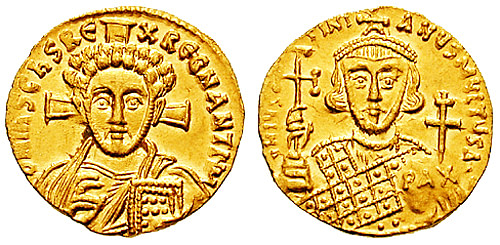
Justinian II “the Slit-nosed” ruled as emperor of the Byzantine Empire in two spells: from 685 to 695 CE and then again from 705 to 711 CE. It was after his first reign and prior to his exile that his nose was cut off by the usurper Leontios and so Justinian acquired his nickname. Unpopular with his people, whom he incessantly overtaxed, and suffering from a justified reputation for cruelty and disproportionate vengeance on those whom he perceived had wronged him, Justinian also struggled on the battlefield. He might have been one of the very few emperors to regain his throne but the fact that he was kicked off it twice by rebellious usurpers with no imperial connections is significant. Seemingly attacking cities at random, butchering anyone remotely regarded as a threat, and even laughing when he lost his own fleet in a storm, Justinian had descended into madness, and his second reign is now remembered as one of the most brutal and terrifying in Byzantine history.
SUCCESSION
Justinian was born in 668 CE, into the Herakleios dynasty, the son of Constantine IV (r. 668-685 CE) and Anastasia. When Constantine died of dysentery in 685 CE, his son and chosen heir, now Justinian II, inherited a troubled empire. The one positive was that Constantine had somehow seen off the siege of Constantinople by the Umayyad Caliphate between 674 and 678 CE. The Arabs, under the leadership of Caliph Muawiya (r. 661-680 CE), had made significant gains in Asia Minorand the Aegean, but when their fleet was torched by Greek Fire in 678 CE, the caliph was forced to sign a 30-year truce with Byzantium. It was the first major defeat the Arabs had suffered since the rise of Islam. In 679 CE Muawiya was obliged to give up the Aegean islands he had conquered and pay a hefty annual tribute.
THE NEW EMPEROR WAS ONLY 16 WHEN HE TOOK HIS PLACE ON THE BYZANTINE THRONE.
Elsewhere, though, the Byzantines had been less successful, and the Arabs in North Africa and the Bulgars and Slavs in the Balkans had been making inroads into the empire. Treaties with the Avars and Lombards, as well as some gains in Cilicia, and the establishment of a protectorate over most of Armenia at least meant the Byzantines were shoring up the holes and slowly turning around the steady decline that had beset them for half a century. There was still much work to do, though.
The young emperor seemed determined to live up to his famous namesake Justinian I (r. 527-565 CE), one of Byzantium's greatest rulers, but, as the historian JJ Norwich here describes, he was not quite of the same calibre:
Intelligent and energetic, he showed all the makings of a capable ruler. Unfortunately, he had inherited that streak of insanity that had clouded the last years of Heraclius and was again apparent in the ageing Constans.Constantine IV had died before it could become manifest; in his son Justinian, however, it rapidly gained hold, transforming him into a monster whose only attributes were a pathological suspicion of all around him and an insatiable lust for blood. (102)
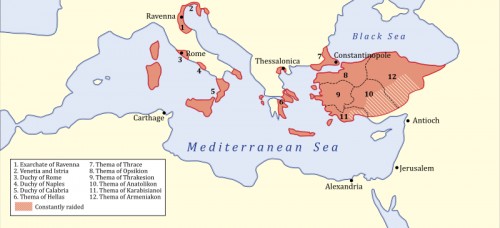
Byzantine Empire, 717 CE
The new emperor was only 16 when he took his place on the Byzantine throne, but, nevertheless, he enjoyed some early military successes in Armenia, Georgia, the Balkans, and Syria. Then, as the Arab armies ignored the agreed truce and pressed further into Byzantine territory in Asia Minor, Justinian was obliged to withdraw his own armies from elsewhere to meet this new threat. Consequently, the gains in the north were gradually lost. Both his spells as emperor would be ones of military weakness, but for the moment, there were more pressing matters to deal with within the empire itself.
DOMESTIC POLICIES
Justinian was a great one for consolidating his territorial gains and cementing into the Byzantine Empire the diverse peoples who made up his subjects by forcibly relocating vast numbers of them. The Mardaites (an independent Christian group in Asia Minor), in particular, were shoved about all over the empire. Cypriots were removed to Kyzikos, the important port on the south coast of the Sea of Marmara. Slavs were another target, they were relocated in large numbers from the Balkans to the province ( theme ) of Opsikion in northwest Asia Minor. Finally, it is likely that Justinian was the creator of the new theme of Hellas (in the Peloponnese and parts of central Greece ) and the kleisoura (military district) of Strymon, east of Thessaloniki.
Despite all this upheaval, or perhaps even because of it, the countryside in many areas of the empire was actually prospering.The class of independent peasants was booming, their living standards were rising and the empire could rely on a solid base for its army's recruitment needs. Justinian then went and rather spoilt it all by raising taxes to an unbearable level. In 691 CE this led to 20,000 Slav soldiers defecting to the Arabs, and Armenia was lost as a result. As revenge for this disloyalty, the emperor picked out a specific target: Slav families in Bithynia. Thousands of men, women, and children were either butchered or thrown into the sea.
As was the case with many of his predecessors, the emperor took a keen interest in Church matters; Justinian was a staunch defender of orthodoxy. One group, in particular, was persecuted, the Paulicians, an Armenian sect which was keen on destroying icons. Monotheletism, that is the belief that Jesus Christ had or has only one will, was also condemned. Justinian convened the Council in Trullo (aka the Quinisextum Council), which met in Constantinople between 691 and 692 CE. The Council issued 102 canons on Church discipline, and when Pope Sergius I refused to accept them, Justinian tried to have him arrested.
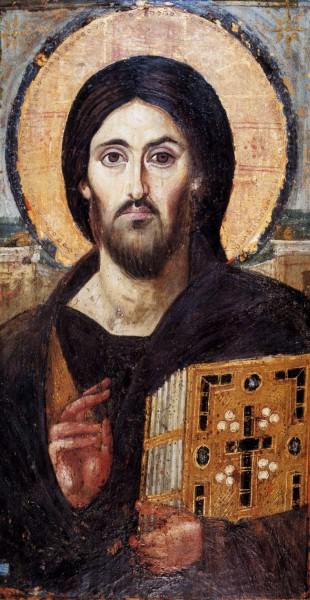
Jesus Christ
The rumpus between the western and eastern churches was, no doubt, once again due to who exactly should have the right to decide the rules of Christianity as the Council's decrees were almost all trivial such as banning the curling of hair in a seductive manner or deciding the number of years of penitence for those who consulted fortune-tellers. There was one ruling which must have hit ordinary folk, and that was a ban on dancing to honour pagan gods and which, therefore, put a stop to masked-theatre, that art form having had a long association with Dionysos. It seems it was not going to be very much fun living under Justinian.
JUSTINIAN'S PIETY IS FURTHER ILLUSTRATED IN HIS GOLD COINS, THE FIRST BYZANTINE COINAGE TO DEPICT CHRIST AS THE MAIN IMAGE.
Justinian's piety is further illustrated in his gold coins, the first Byzantine coinage to depict Christ as the main image. The bearded and long-haired representation became the standard one for coins of the empire thereafter. The legends of Justinian's coins read: “ Jesus Christ, King of those who rule” on the obverse and “Lord Justinian, the servant of Christ” on the reverse, which showed the emperor holding a cross. During his second reign, Justinian's coins depicted Christ more unusually as beardless and with short curly hair.
EXILE
Then, in 695 CE, disaster struck Justinian's reign when the usurper Leontios (r. 695-698 CE), an ambitious general and commander of the Hellas province, seized the throne for himself. The general, the most senior in the army at the time, was backed by a wave of popular discontent from the peasantry at Justinian's continual heavy taxes and the outrage of the aristocracy at the constant extortion perpetrated by the emperor's entourage, led by the fearsome whip-carrying eunuch, Stephen of Persia.
Leontios, who had already been imprisoned for his ambitions between 692 and 695 CE, got his revenge by first parading Justinian in chains around the Hippodrome of Constantinople and then infamously slitting the nose of the emperor, a punishment which was designed to prevent him from holding future office as the convention was that an emperor had to be free of physical imperfections. Justinian, henceforth known as “the Slit-nosed” ( rhinotmetos ), was then exiled to Cherson in the Crimea. Others who had been closest to the throne were less fortunate - dragged through the streets of the capital behind wagons, they were then burned alive in the Forum Bovis.
Leontios' unsuccessful reign only lasted three years, and its chief low points were a devastating outbreak of plague and the loss of Carthage to the Arabs in 697 CE. In 698 CE he was himself removed by another usurper, Apsimar, a military commander in the Kibyrrhaiotai theme in southern Asia Minor. Ironically, Apsimar had been sent by Leontios to retake Carthage but, failing to do so, he returned and used his fleet to oust the emperor instead. In the usual “what goes around, comes around” of the Byzantine court, Leontios had his nose cut off and was exiled. Tiberios III, as Apsimar was now calling himself, did not achieve much more than his predecessor, though, and he oversaw both a failed invasion of Syria and the loss of western North Africa to the Arabs.
SECOND REIGN
With the empire in trouble, Justinian was able to make his move to return to power. Crucially, the ex-emperor had the help of both his future son-in-law Tervel, the Khan of Bulgaria (r. 701-718 CE), to whom the emperor had promised his daughter in marriage, and the Khazars, the semi-nomadic Turkish tribe on the other side of the Black Sea. The Khazar leader Ibuzir became Justinian's brother-in-law as the would-be two-time emperor promptly married his sister Theodora. In 705 CE Justinian and his extended family besieged Constantinople. Tiberios had prudently repaired the ageing sea walls of the city, but only three days after setting up camp outside the Theodosian Walls, the attackers gained entrance by an aqueduct pipe. Caught by the total surprise, the palace guards surrendered, and Tiberios fled to Bithynia. Justinian, now wearing a gold false nose, was back on the throne in the golden reception room he had himself added to the Great Palace. He then crowned his foreign-born wife Empress Theodora, an unprecedented move.

Justinian II & Tiberius
The emperor's second spell of rule (705-711 CE) revealed him as a nasty tyrant, and his first act was revenge. Tiberios was pursued and captured while Leontios was brought back from exile. Both were paraded in chains in the Hippodrome, pelted with excrement, and then executed. Next, Justinian went for the army and those generals who had sided with Tiberios. The biggest name was the ex-emperor's brother, Heraclius, but many others were hanged in a public display along the city's Theodosian Walls. The bishop of Constantinople who had crowned both of the two usurpers was blinded and exiled. Still others who were deemed of dubious loyalty were sown into sacks and lobbed into the sea.
THE MILITARY SITUATION WAS NOT AT ALL HELPED BY THE EMPEROR'S MURDER OF JUST ABOUT ANY CAPABLE OFFICER IN THE BYZANTINE ARMY.
On the military front, Justinian proved as ineffective as ever in stopping the Arabs overrunning much of Asia Minor from 709 to 711 CE. The situation was not at all helped, of course, by the emperor's murder of just about any capable officer in the Byzantine army. Tyana in Cappadocia was lost to the Arabs in 709 CE. A Byzantine attack on Ravenna - of mysterious motivation - was carried out with success in the same year, Justinian having had all the nobles of the city rounded up, shipped to Constantinople and then executed. Despite this attack so close to home, the new Pope, Constantine, travelled to Constantinople in 711 CE, and a reconciliation was made after the upset over the Council in Trullo. It would be the last time a Pope visited Constantinople until Paul VI in 1967 CE.
The cordial interlude of friendship was interrupted by Justinian making more enemies for himself and attacking Cherson - perhaps in vengeance for having been exiled there, but now just about all of the emperor's actions seemed like madness. The city was sacked, seven key nobles were roasted alive while others had weights tied around their legs and were thrown into the sea. On the way home, though, Justinian's entire fleet was sunk in a storm. The emperor was said to have laughed when he heard the news.
Then a serious rebellion broke out led by the general Philippikos in 711 CE. Once again, Tervel stepped in and provided the emperor with an army of 3,000 men. Tervel had already been granted the title of Caesar and given a favourable trade deal, but his force was not enough to turn the tide of change, and Justinian was ousted for the second time.
DEATH & SUCCESSORS
Philippikos, backed by the Khazars who had just retaken Cherson, supported by the Byzantine army, and bolstered by the news that other parts of the Crimea had already rejected Justinian's right to rule, seized power in 711 CE. To ensure there would be no third time lucky for Justinian, the emperor was executed on 4 November 711 CE. Shortly after, his son and co-emperor Tiberius was murdered too, along with most of his father's advisors. Philippikos would, though, reign for less than two years as the Byzantines witnessed an ever-changing roundabout of emperors and ever-more calamitous military defeats abroad. The trend would continue, too, until Leo III took the throne and provided some much-needed stability between 717 and 741 CE.
Marcus Claudius Marcellus › Who Was
Definition and Origins
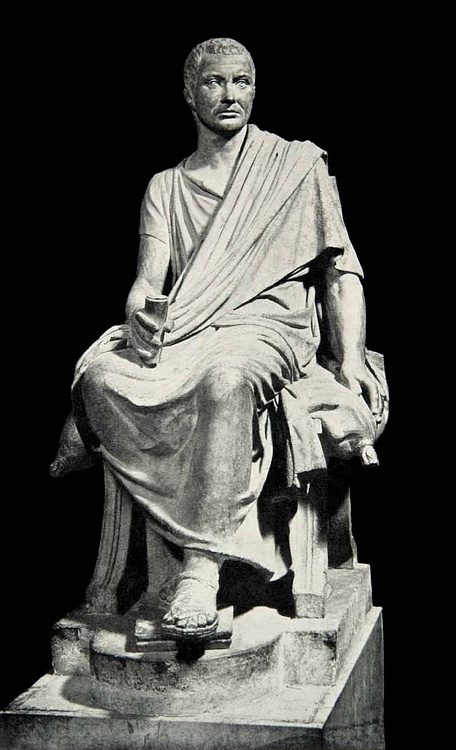
Marcus Claudius Marcellus (c. 270-208 BCE) was a five-time consul and, earning the nickname the 'Sword of Rome ', he was one of the city ’s greatest military commanders. Active in both the First and Second Punic Wars, he also won honours for his campaigns in Gaul and the capture of Mediolanum (modern Milan). Battling Hannibal in southern Italy and then famously capturing Syracuse on Sicily, Marcellus' run of victories came to an end when he faced the Carthaginian general in 209 BCE. One year later the Roman commander was killed in an ambush near Venusia (modern Venosa), where his tombmarker still stands today. He is not to be confused with Emperor Augustus ' nephew of the same name.
EARLY CAREER
Marcellus was born c. 270 BCE and first gained recognition as a military tribune during the final years of the First Punic War(264-241 BCE) against Carthage. He was made (at unknown dates) an augur, curule, quaestor, then an aedile c. 226 BCE, and finally a praetor as he climbed up the various political rankings of ancient Rome. According to the Greek -Roman writer Plutarch (c. 45 - c. 125 CE) in his biography Marcellus, he had a son, Marcus. Plutarch, in his opening paragraph, describes the character of Marcellus in the following terms:
He was, indeed, by long experience, skilful in the art of war, of a strong body, valiant of hand, and by natural inclinations addicted to war. This high temper and heat he showed conspicuously in battle ; in other respects he was modest and obliging.
MARCELLUS RECEIVED THE GREAT HONOUR OF THE SPOLIA OPIMA OR 'SPOILS OF HONOUR' FOR KILLING HIS OPPOSING COMMANDER VIRIDOMARUS.
NORTHERN ITALY CAMPAIGNS
Marcellus was made consul for the first time in 222 BCE. It was a role he would take on four more times in 215, 214, 210, and 208 BCE, an unusual run made possible by the suspension of the usual election rules during the long Second Punic War(218-201 BCE). In his first consulate he established his reputation for skill and courage on the battlefield. Campaigning against the Gauls in northern Italy, he rescued Clastidium (modern Casteggio) from imminent collapse. Then, with help from Cornelius Scipio Calvus, he captured Mediolanum and famously led a cavalry charge which allowed him to kill the Insubrian chief Viridomarus in single combat. He received the great honour of the spolia opima or 'spoils of honour' for the deed - one of only a handful of such commander-duels in Roman history - and a triumph for his campaign. Marcellus' exploits were then celebrated in a popular play of the time by Naevius, Clastidium. Marcellus himself dedicated a temple to both Honos and Virtus, the Roman gods of Honour and Virtue respectively, although the project was not actually finished until 208 BCE.
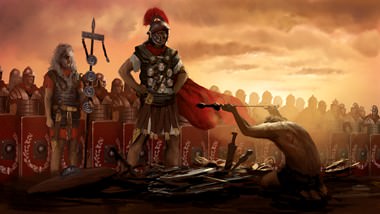
Roman Victory
SECOND PUNIC WAR
During the Second Punic War the horrors of war came much closer to home for the Romans, and commanders like Marcellus would have to face their greatest challenge. In 216 BCE Marcellus was praetor again and he was sent to defend the city of Nola in Campania from attack by the Carthaginian general Hannibal who had now invaded Italy and already won significant battles at Ticinus, Trebia, Lake Trasimene, and Cannae (218-216 BCE). Nola was held, and Marcellus was briefly given a consulship for the second time in 215 BCE before he was forced to step down, probably because his election meant neither consul was of the patrician class. Instead, he was given a proconsul command and then made consul the year after.
AFTER TAKING LEONTINOI, MARCELLUS SET HIS SIGHTS ON THE JEWEL OF SICILY, FORTRESS SYRACUSE.
In 214 BCE Marcellus again defended Nola against Hannibal's forces and then recaptured from the enemy Casilinum on the Via Appia. The Roman general next switched battlefields to Sicily. After taking Leontinoi, Marcellus set his sights on the jewel of Sicily, fortress Syracuse. He blockaded the harbour with 60 artillery-mounted ships and attacked from the sea while Claudius Pulcher led an army on land to bombard the city from two sides. Still, the defenders had an ace up their sleeves in the form of the brilliant scientist and inventor Archimedes whose wicked artillery and grappling machines managed to keep the Romans at bay. After an eight-month siege, and despite Carthage sending an army of 23,000 in support, the city did finally fall in 212 BCE. The capitulation of the fortress was largely thanks to several mercenary leaders defecting to support the Romans. It was they who told Marcellus that the defenders were in the midst of a festival to honour Artemis, and the general took swift advantage by launching a night attack that took the city. In the chaotic aftermath of the city's occupation, Archimedes (and many others) were ruthlessly killed, although Marcellus had ordered that the scientist be spared.
Marcellus promptly shipped back as much fine art booty as he could lay his hands on from his new prize in an innovative and highly successful strategy to impress his fellow Romans. Marcellus would be criticised by the historian Polybius (c. 200-115 BCE) not because it was wrong to take from the conquered but because it was dangerous to adopt the luxury-loving ways which had softened them up for defeat. The range and excellence of the Greek art which found its way from Sicily to Rome did have one effect, to inspire Roman artists to greater endeavour in their own paintings and sculpture.
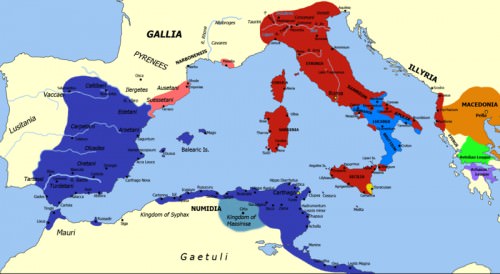
Territories During the Second Punic War
More victories on the island, which included dispensing with surviving Carthaginian forces at Agrigento, ensured Marcellus fully deserved his ovatio (one step down from a full Triumph) in Rome in 211 BCE. They were the first military celebrations of the Second Punic War and, with Scipio Africanus ' victories in Spain in 209 BCE, the conflict was finally swinging Rome's way.
The wings of fortune might have been fluttering on the side of the Romans but they still had a lethal enemy encamped in the south of the Italian peninsula to deal with. Marcellus overturned the established Roman strategy of not trying to face Hannibal's army in direct battle. Ever since Cannae and their heavy defeat there the Romans had adopted the so-called 'Fabian policy', named after Fabius Maximus Verrucosus, the dictator of 217 BCE, who earned the nickname 'Cunctator' (Delayer). Fabius knew that Hannibal might win direct confrontations but he could be worn down by attacking his allies and blocking his supplies by sea. Marcellus, on the other hand, was now eager to meet the Carthaginian head on and settle the issue sooner rather than later. The more aggressive commander thus earned the later historian Posidonius' name for the pairing of Maximus and Marcellus as Rome's 'Shield and Sword' respectively.
DEATH & LEGACY
Made consul once again in 210 BCE, Marcellus was, no doubt, confident after his own victories against the Gauls and Sicilians that he could match Rome's great nemesis on a level battlefield. However, in 209 BCE, with Marcellus this time acting as a proconsul, when the pair finally met on the battlefield at Canusium the Carthaginian won. Criticised for being too passive at Canusium, fate would not give Marcellus an opportunity for revenge as he was ambushed near Venusium in southern Italy in 208 BCE. Again serving as consul and preparing to attack Locri with his colleague Quinctius Crispinus, Marcellus was killed outright while Crispinus was wounded (but died later). According to the Roman writer Livy (64/59 BCE - 17 CE), Hannibal showed the decency to give Marcellus a proper funeral but he also used the Roman's signet ring to try and deceive towns loyal to Rome with forged letters, notably Salapia. The ruse was unsuccessful because Crispinus had managed to inform them of Marcellus' death.
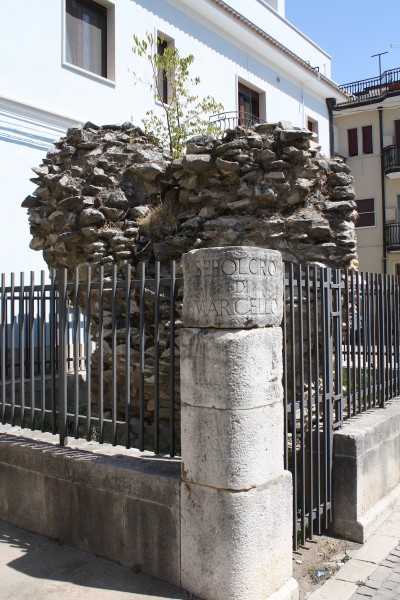
Tomb Marker of Marcellus
Meanwhile, Hannibal had the bones of Marcellus sent to Rome in a silver urn with a gold crown. Unfortunately, according to Plutarch, a contingent of Numidians intercepted the mission and cast the bones unceremoniously to the ground where they were left and lost. Livy, on the other hand, reports that the relics safely reached Rome. The speech of Marcellus' son, delivered at his father's funeral, was later published. The remains of the stone monument thought to mark the warrior's tomb still stands, rather forlornly it must be said, in modern Venosa, tucked away in an ordinary row of street houses. The great general was honoured by various statues and monuments around the Mediterranean and one, at Lindus, according to Posidonius (quoted by Plutarch) carried the following inscription:
This was, O stranger, once Rome's star divine,Claudius Marcellus of an ancient line;To fight her wars seven times her consul made,Low in the dust her enemies he laid.
Marcellus's loss was a heavy blow for Rome - he had been in a position of imperium command throughout the previous decade - but Hannibal would soon be forced to return to Africa and defend Carthage against Scipio Africanus' attacks.Carthage's long war with Rome would end in defeat at the Battle of Zama in 202 BCE. Marcellus' reputation and fame would continue well beyond his own death. Livy was a little critical, suggesting the commander was rather pedantic and too superstitious, but Plutarch gives a more glowing character portrait, albeit one meant to fit in his scheme of parallel biographies with Greek commanders. Still, Marcellus' successes in Gaul and the taking of mighty Syracuse are undisputed history. In addition, as one of Rome's great commanders and a symbol of honourable leadership, his campaigns against the Gauls were cited in the Augustan fasti records two centuries later as the epitome of Roman virtue.
LICENSE:
Article based on information obtained from these sources:with permission from the Website Ancient History Encyclopedia
Content is available under License Creative Commons: Attribution-NonCommercial-ShareAlike 3.0 Unported. CC-BY-NC-SA License